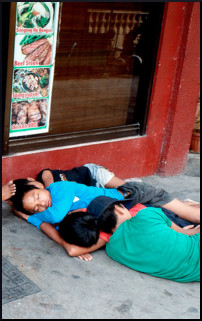
House the Homeless has spoken about the urgency of telling potential presidential candidates what we think is important. Keeping families together is maximally important.
It has long been obvious that one person working a minimum wage job can barely support herself or himself. With kids, the situation becomes desperate. When a person is called upon to do two different things at the same time, like hold a job and be the sole parent, the awful stress of trying to do the impossible has a bad effect on health and mental stability. Even if there are two parents, if one has a low-paying job and the other takes care of the kids, they are teetering on the edge of homelessness if not homeless already.
The number of families living in garages and basements is larger than official statistics would indicate. But in recent years, even if both parents work, or one parent holds two jobs, in many places they still can’t afford a place to live that includes such amenities as running water, electricity, outdoor space for kids to play, or indoor space for them to do school assignments.
The flyover states
Too often, a cruel Catch-22 comes into play. There are plenty of places in the United States where the rent is relatively low. Unfortunately, such a place is unlikely to offer the luxury of employment. Journalist Alexis Rosado quotes experts from Volunteers of America and Homeless Angels, to the effect that, although most people don’t realize it, families with children make up a huge proportion of the homeless population. This is certainly true in middle America.
Just last week, WLNS in Lansing, Michigan, profiled a family that has been experiencing homelessness for about two years since the father lost his job and couldn’t find another. Lansing only has two facilities where families can stay together, and then only for a short time. A lot of other cities don’t even have that much.
Audacious programs
Kids in tumultuous situations are prone to physical, emotional, social, and developmental problems, or all four kinds at once. In Oakland, CA, the Center for the Vulnerable Child (CVC) focuses on children whose lives are impacted by homelessness, family disruption (often a polite way of saying that a parent is locked up), abuse, neglect, violence, poverty, and other chaotic influences. Cheryl Zlotnick published a book titled Children Living in Transition, which describes the organization’s focus:
[…] this text recommends strategies for delivering mental health and intensive case-management services that maintain family integrity and stability.
[…] this volume outlines culturally sensitive practices to engage families that feel disrespected by the assistance of helping professionals or betrayed by their forgotten promises. Chapters discuss the Center’s staffers’ attempt to trace the influence of power, privilege, and beliefs on their education and their approach to treatment.
The CVC offers developmental screening, education in parenting, therapy for both individuals and families, and case management. It is connected with many programs that serve niche demographics, like foster kids who need medical care, or children who seem likely to fail out of kindergarten, so clients can be referred to numerous consulting specialists.
In nearby San Francisco, the Homeless Youth Alliance works with a very different group – youth designated as “unaccompanied,” who are either alienated from their families or who have aged out of foster care and never had families. They are encouraged to be more than the passive recipients of services. There is a neighborhood beautification crew that increases pride and earns good will, and the opportunity is always open to work as an outreach counselor.
Funded mostly by foundations and private donors, the HYA encourages people to accept challenge and be the change they want to see in the world. To potential supporters, executive director Mary Howe issues a refreshingly honest call to action:
We want your money, your talent, your support and, more than anything, your ability to utilize your own voice to educate people of the root causes of poverty, homelessness, drug use and mental health challenges… Don’t just sit on your ass and complain about the state of things—stand up, do something and get involved in your community.
Circling back to our first paragraph, House the Homeless would like to remind everybody that now is an excellent time to get involved by raising our voices about what needs to be done on a national level. Any pubic figure who aspires to leadership should be hearing from us, and not just that we want more and better homeless shelters. No, we want improvement in all the circumstances and conditions that lead to homelessness, which are conveniently listed on the page titled “Mission: School the Candidates.”
Source: “Homeless family sees flaws in the system,” WLNS.com, 02/19/16
Source: “Children Living in Transition,” Columbia.edu, 2014
Source: “Create to Destroy! Homeless Youth Alliance,” MaximumRocknRoll.com, 10/22/13
Photo credit: Blemished Paradise via Visual hunt/CC BY-SA


